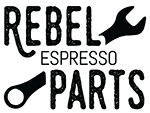What’s the difference?
By Chase Lemos
Not all burrs are created equal. The design of the burr coupled with the materials it is made from can change a lot about how the coffee turns out. Burrs have a usable lifespan and then they need to be resharpened or thrown out. Burr life depends on a number of factors – metal composition, geometry of the cutting surface, size of the burr and the type of coffee being ground.
Metal composition
Most grinders come standard from the factory with oil quenched steel burrs. These are the most common type of burr out there and can be identified by their matte-grey appearance. These standard burrs have a tough outer shell of hardened steel with a soft inner core. They can be thought of like an M&M chocolate candy. The shell is hard to protect the inner steel. The life of these burrs is determined by the harder outer layer, once you reach the soft inner steel they wear very quickly and need to be replaced. In a 64mm burr this happens around the 650-750lb mark.
The next level of grindstone is the Extended Life. These burrs are reasonably priced and offer an improvement in life over standard burrs (as the name suggests). Extended Life burrs can be recognized by the increased shine and more silver color (over the standard burr). These burrs have a hard(er) outer shell with a soft inner core. Due to the process with which they are ‘quenched’, they have a lower friction coefficient than standard oil quenched burrs which results in less wear on the burr per measure of coffee ground. The more advanced process used to harden the outer layer does add to the cost of the burr right out of the factory. These burrs, in 64mm, will last for around 1,000 to 1,100lbs.
Above Extended Life burrs are the Chromoly Steel burrs. This burr is moderately priced because the price of the raw steel is more than the Standard or Extended Life burrs. The advantage of this step-up in raw material is a burr that is tougher and hard all the way through. 64mm Chromoly Steel Burrs can grind around 1500-1600lbs of coffee before they need to be replaced.
Tool Steel burrs (D2) are the cream of the crop in terms of uncoated burrs. These burrs start to cross into the pricey category. They are hard all the way through with an excellent hardness rating. This category of steel was specially formulated to have low abrasion resistance allowing it to wear slowly. The draw back is that it must be heated to a very high temperature to be workable. This requires special equipment for the burr manufacturer and is part of the reason these burrs carry a premium price tag. These burrs in 64mm will grind 2400-2500lbs before they need to be replaced.
To get any more production out of a set of burrs, you have to start coating the steel with other super-substances. The most common one is Titanium Nitride (TiN). It is identifiable because of the gold coloration the TiN coating puts on the burr. In order to apply the coating, the steel must be super-heated which can cause most steel burrs to warp. Because of this, it is necessary to use Tool Steel as the base for TiN burrs. This results in a very hard steel with a very low friction coefficient. This means that you first wear out the TiN and then you wear out the Tool Steel creating a 64mm burr that will grind 3,000-3,100lbs before it needs to be changed.
Ceramic burrs will go about the same duration before they need to be changed. The marked difference between TiN and Ceramic burrs are the thermo-properties of the material. The steel will hold the heat while the ceramic will not hold very much heat. There are differing viewpoints as to which is preferable. The first thought is that ceramic burrs are preferable because they will not heat up and so they shouldn’t ‘cook’ the coffee during grinding when compared with the steel which will get hot after several subsequent grinds. The second thought is exactly the opposite – the steel is better because it holds the heat. This means that the heat is captured in the burr and is radiated away while the grinder sits idle while the ceramic burr won’t hold any heat (but will create heat) meaning that the heat must be absorbed by the grinder motor or by the coffee. This would mean that ceramic burrs will have a larger ‘cooking’ effect on the coffee than steel burrs. We do not yet have enough evidence to prove which way of thinking is correct. I would argue that the correct answer probably depends on your volume of coffee per hour. Given that the goal is a perfect cup of coffee first and worrying about grinder longevity second, I would think that steel will preform better at light to moderate usage while ceramic burrs will cause less damage to the coffee during especially heavy traffic hours.
Burr Geometry
The geometry of the cutting surface can completely change the way that grinder burrs work in your grinder. There are several issues that burr geometry can either cause or remedy. The first of these is when a set of burrs causes your grinder to clog. This is generally due to the primary cut of the burr (the largest cut on the inside of the burr). When your primary cut is too choked off (the angle formed off the radius line by the cut is too great) can result in clogging with darker coffees.
The second issue that stems from burr geometry is your grind speed. Grind speed changes from one burr to another due to the angle at which the secondary and tertiary cuts meet. The outer two cuts form a scissor with their other half (the other burr) – the steeper the angle at which the ‘scissors’ meet the faster the burrs will grind but the more load you will put on the motor and the capacitor. Alternatively, of the angle is shallow, you will grind more slowly but it will be easier on the motor and capacitor. The outfall depth (if you line up the teeth of the burr so you can see the hole created by the matched low point in the tooth pattern, the hole created is the outfall) will impact grind speed at the cost of fine/course ratios. Larger outfall depths will allow a faster grind with a wide variation between fines and courses while a smaller outfall depth will allow a greater consistency from fine to course particles at the cost of grind speed due to the alignment and subsequent misalignment of the cutting channels.
The size of the burr will influence the amount of work a set of burrs are able to do. The larger the burr, the more spread out the job of breaking down the bean will be and the longer the burr will last. Larger steel burrs are able to accumulate more heat but will take longer to cool down once they get hot. A burr with larger cutting beds will accumulate less heat as it grinds because it will be able to more gradually step down the bean particulate (won’t have to break it all at once).
Coffee Roast Effect on Longevity
As coffee roasts, it releases water, expands and becomes less dense. This means that the roast being ground on the burrs will impact the life of the burr. A darker roast will be a less dense bean, and therefore will be easier to ‘cut’. As such, dark roasts will wear down burrs less quickly.
Lighter roasts have more retained water in the bean and will present a greater challenge to break down. Lighter roast coffees do dull burrs faster than darker roasts.
White coffee is still very hard and will wear out the burr much more quickly than the stated wear rate would suggest. They may also have a negative impact on the life of your capacitor and motor in your grinder.
Rocks are another object that are rather difficult for espresso grinders to break down. The steel may be able to make some progress, but will generally become unusable if the rock is allowed to remain in the grinder for any period of time. The rock may also simply bind the burrs together and not allow them to move past one another with could cause a broken sheer pin or eventually a worn out motor. Rocks are not recommended to be run through your espresso grinder (neither are screws, or any other foreign object).
Spices are another thing that some customers like to feed into their espresso grinders. Black pepper, cinnamon and other tasty morsels wreak havoc on burrs and grinder components alike. Espresso grinders are highly adapted to evenly and effectively break down coffee beans, they were not designed with spices in mind. In theory, a grinder may be able to break down these substances, however, the fine particulate may end up in unintended locations and ruin the grinder. The spices may also leave behind a non-coffee flavor that will season subsequent shots (as will flavored coffee).
Burr Wear
New burrs are quite sharp and can ‘cut’ the coffee differently during their brand-new ‘break-in’ period than they will after they have accumulated some wear. Because of this, burrs will have to be constantly re-calibrated, especially in the first couple weeks of use. Your espresso may pull faster through a newer set of burrs because the particulate will have a sharper edge to it causing it to settle less well into its neighbors and allow for more avenues of water travel.
Alternatively, dull burrs are not good for quality espresso either. Dull burrs take longer to grind a measure of coffee and will squish the coffee more than they will cut it. This will cause them to heat up more quickly. This crushed coffee will be more like peanut butter and can cause increased clogging and longer shot times. The crushed coffee will look almost round under magnification causing it to tamp poorly (increasing channeling). The best espresso can be achieved using a burr that is between brand new and worn out (don’t worry this is about 99% of a burrs life span).
To test burr sharpness, drag the top of a fingernail over the leading edge of the burr. If the burr catches and pulls or digs into the nail, the burr is still plenty sharp. If the burr does not bite, then it isn’t biting into the coffee either and needs to be replaced.
Burr Maintenance
Burrs do like to be maintained. All they really need is to have the grind chamber occasionally vacuumed out and to have a product like Puly Grind run through the grinder at least once a week (maybe even daily, depending on coffee volume). This regular maintenance will improve the flavor of the coffee by pulling out putrid coffee oils that are literally rotting in your grind chamber. The fix isn’t terribly expensive, in dollars or in time, and can help prevent clogging.
Instant rice can be run through a grinder to much the same effect as a specialized chemical cleaner, but can VOID THE MANUFACTURER WARRANTY ON A GRINDER. If you are cleaning a grinder for a client, please do not use instant rice. Please use an appropriate product that has been approved by the grinder’s manufacturer. This will protect both your client and yourself and may even allow you to sell another product to your regular customers.







